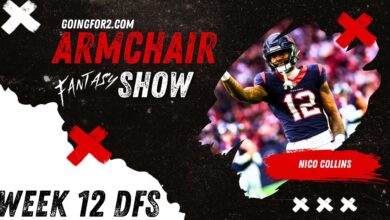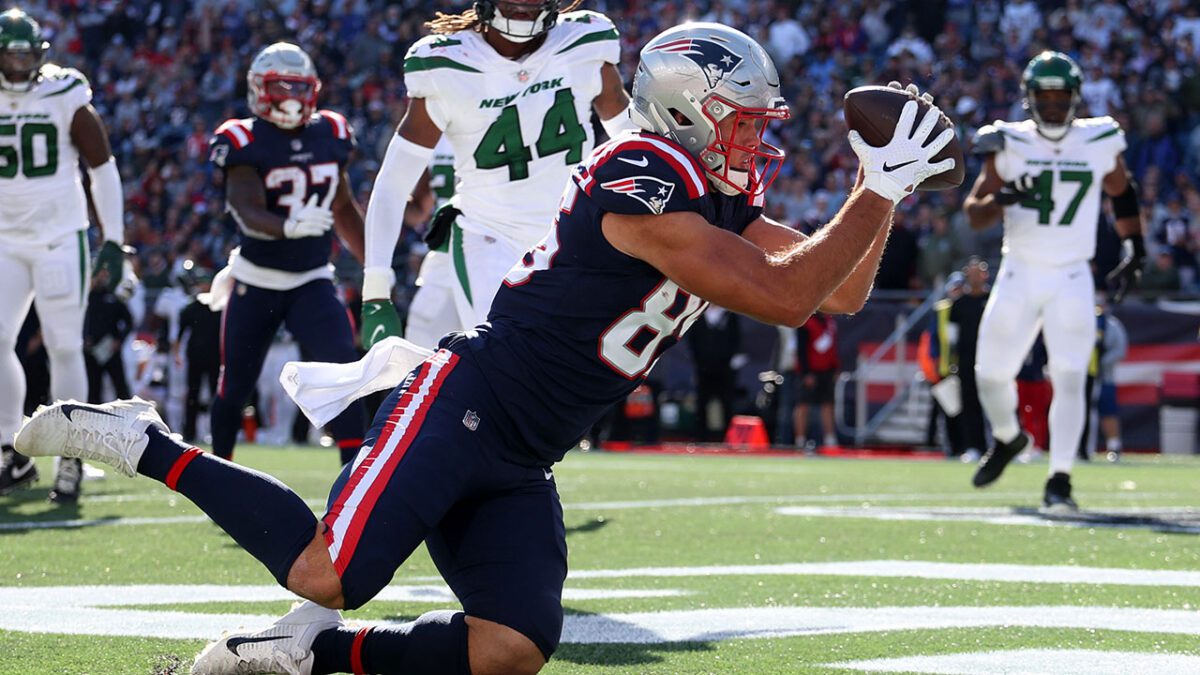Beware the Tyler Boyd Breakout Season in Fantasy Football
Bengals wide receiver Tyler Boyd struggled in his first two NFL seasons but found his footing in 2018. He made a leap in production by posting career highs in targets, receptions and receiving yards. His seven touchdowns and 1,028 receiving yards were both more than he caught in his first two seasons combined.
This offseason, his fantasy football stock is trending up and he’s been showered with love by the fantasy community on Twitter. According to FantasyPros, he’s currently being drafted as WR23, ahead of Calvin Ridley, Tyler Lockett and Mike Williams, to name a few. But gamers must decide if his recent production is an outlier or a sign of things to come, and how A.J. Green affects Boyd’s play. Digging into Boyd’s production, profile, efficiency and fit with the offense under new head coach Zac Taylor provides insight into his season outlook.
The Production Finally Happened
It’s hard to argue with 1,028 yards and seven TDs, so Boyd has at least proved he’s got that kind of production in him after his first two seasons were duds. He posted solid marks with 639 air yards and 389 yards after the catch, which ranked No. 19 and 16 in the league, respectively, according to PlayerProfiler. It’s the kind of season Cincinnati expected from Boyd after drafting the former Pitt product in the second round.
Coaching Changes Benefit Boyd
That Cincinnati finally fired head coach Marvin Lewis and hired Zac Taylor should aid in Boyd’s development. Taylor was the quarterback’s coach of the Sean McVay-led Rams in 2018 and also spent 2017 as the team’s assistant receivers coach. Like McVay, he’s viewed as an offensive guru who can take teams to new heights. Last season the Rams ranked No. 4 in passing yards per attempt (8.6), while the Bengals mark (6.6) ranked No. 27.
Also joining Taylor’s staff is offensive coordinator Brian Callahan, who most recently was the quarterback’s coach for the Raiders. He helped Derek Carr throw for a career-high in passing yards and lead the AFC in completion percentage last season. The arrival of Taylor and Callahan boosts the outlook of the entire Bengals receiving corps, but it’s critical to consider how Boyd will fit in the new offense.
Green is on the record saying he expects the Bengals to score more points and take more down-field shots under Taylor. That’s good news for Green, whose 2018 yards per reception (15.1) and average target distance (13.6) both ranked much higher than Boyd’s.
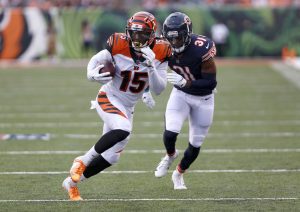 The Bengals also have third-year speedster John Ross, who runs a blistering 4.22 40-yard dash. That’s faster than Tyreek Hill (4.34). While Ross has been slow to develop and has struggled with drops, he did show a nose for the end zone last season by catching seven TDs. That’s the same number of TDs as Boyd caught, only on 50 fewer targets. Ross could excel in a new offense that wants to throw the deep ball, which would breathe new life into his fantasy outlook.
The Bengals also have third-year speedster John Ross, who runs a blistering 4.22 40-yard dash. That’s faster than Tyreek Hill (4.34). While Ross has been slow to develop and has struggled with drops, he did show a nose for the end zone last season by catching seven TDs. That’s the same number of TDs as Boyd caught, only on 50 fewer targets. Ross could excel in a new offense that wants to throw the deep ball, which would breathe new life into his fantasy outlook.

Boyd profiles as a possession receiver and doesn’t have the speed to beat defenses over the top. He works primarily out of the slot and played 67-percent of his snaps there in 2018. Boyd had one play of 40 yards or more last season, one play of 20-plus yards in 2017 and his longest play went for 30 yards in his rookie season. He’s never been a big-play guy.
Boyd Sports Lackluster Workout Metrics, Efficiency
Certain aspects of Boyd’s workout metrics and efficiency raise red flags that gamers are glossing over. His 4.58 40-yard dash and 4.35 shuttle times barely meet the minimum threshold of elite NFL receivers (4.60; 4.35). His marks in vertical 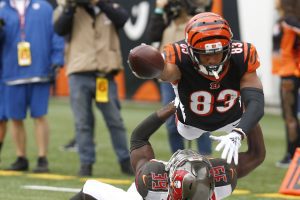 jump (34) and broad jump (119) failed to meet the minimum thresholds, but he did score better in 3-cone (6.90). Those marks put into question Boyd’s ability to be an elite NFL wide receiver.
jump (34) and broad jump (119) failed to meet the minimum thresholds, but he did score better in 3-cone (6.90). Those marks put into question Boyd’s ability to be an elite NFL wide receiver.
In terms of efficiency, Boyd underwhelmed last season in several key categories. His marks in YPR (13.5) and ATD (9.9) ranked No. 47 and 73, respectively, according to PlayerProfiler. For a primer on why ATD matters, click here.
The Bengals are Bad on Both Sides of the Ball
The Bengals ranked No. 24 in passing offense in 2018. Their 3,290 passing yards were 1,835 less than league-leading Tampa Bay (5,125). In his eight NFL seasons, Bengals quarterback Andy Dalton has thrown for more than 4,000 yards twice. Some of that can be chalked up to Marvin Lewis, but it should be viewed with caution in relation to Boyd’s production. The best players to target from a fantasy perspective play for the best offensive teams. That’s not the Bengals.
The Bengals finished dead last in total defense in 2018, and according to Football Outsiders their 27:27 average time of possession was second to last. Cincinnati couldn’t keep its offense on the field, and in an ironic twist, the Bengals controlled the ball longer when they were trailing than when they were leading. That backward game flow further explains the lack of passing production.
Love our content? Check out the GoingFor2 Live Podcast Network!
Can A.J. Green Resume His Rockstar Status?
Green has been the team’s leading receiver for most of his career and only missed a total of four games across his first five seasons. But he missed seven games in 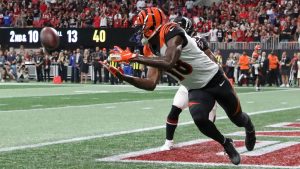 2018 (toe) and six games in 2016 (hamstring). Green had offseason surgery to repair ligaments in his right toe and will be 31 when the season starts. That coupled with the wear-and-tear of eight pro seasons on his body signals a looming drop-off in production. Green’s absence last season opened up his team-leading target share for Boyd, but statistics show he needs Green drawing coverage to succeed.
2018 (toe) and six games in 2016 (hamstring). Green had offseason surgery to repair ligaments in his right toe and will be 31 when the season starts. That coupled with the wear-and-tear of eight pro seasons on his body signals a looming drop-off in production. Green’s absence last season opened up his team-leading target share for Boyd, but statistics show he needs Green drawing coverage to succeed.
For example, five of Boyd’s seven TDs in 2018 came with Green in the lineup. Further, five of his six best fantasy finishes occurred when Green was healthy. Simply put, Boyd struggles when he’s the best receiver on the field because he’s not an elite receiver. The presence of Green or another elite WR to draw the attention of defenses will be key to Boyd’s production for years to come.
Target Distribution Tells More of the Story
While Boyd (108) and Green (74) took home the biggest piece of the target share, there are other factors to consider. Fourth-year tight end C.J. Uzomah enjoyed the highest volume of his career (64 targets) in 2018, and the Bengals threw to their running backs 111 times, the 12th-most in the league. Uzomah and the entire RB corps are returning, as is Tyler Eifert.
Eifert, the rising star tight end who many gamers left for fantasy dead, figures to start the season healthy. Although he’s battled a litany of injuries throughout his career, he proved a worthy red zone target in 2015 by catching 13 TDs and recording 615 receiving yards.
The Verdict
The Bengals didn’t draft a wide receiver, so Boyd looks locked in as the team’s slot guy. That shouldn’t change much under Taylor despite whatever new scheme he and Callahan install. But regardless, this is very much the same team that finished No. 24 in 2018 and No. 32 in 2017 in total offense. Green’s age and recent injury history cast doubt on his ability to play a full season in 2019. Ross looks ready to take another big step forward in his development.
All of these factors hurt Boyd’s fantasy outlook, so I anticipate both TD and receiving yards regression for him. That’s not to say he won’t be productive and I don’t expect a huge dip. However, there are other receivers in the same ADP tier as Boyd who I’m higher on that have a great shot at producing better ROI, including Chris Godwin, Calvin Ridley and Tyler Lockett. I also like the aforementioned players’ dynasty outlooks more than Boyd’s.
Boyd finished last season as WR 17 in PPR formats and will be hard pressed to repeat that production in 2019. Savvy gamers shouldn’t get too high on Boyd and draft him only if his ADP makes sense to provide solid ROI.
ATTN Dynasty Commissioners: Do you want to do something cool for your league? How about a 1-hour live show dedicated to YOUR league? Team-by-team breakdowns, rankings, and more. For details and to book a show, visit: GoingFor2.com/plp.



